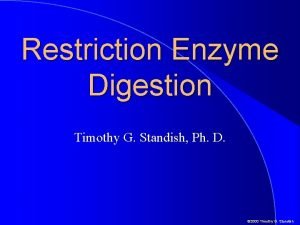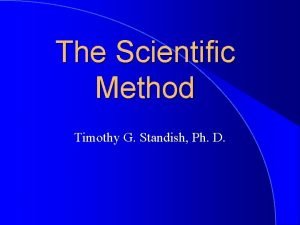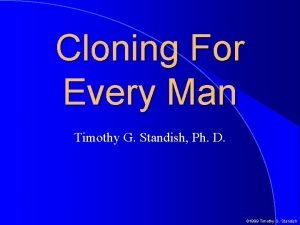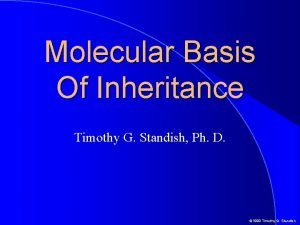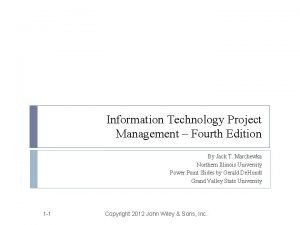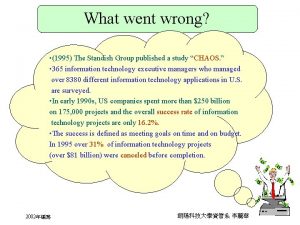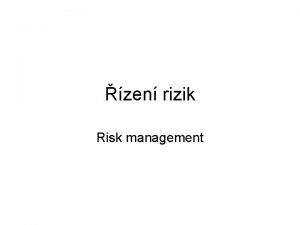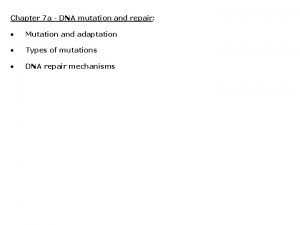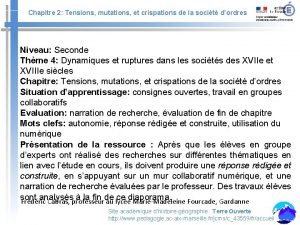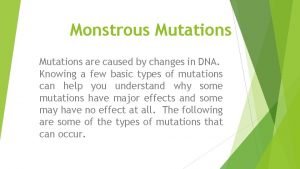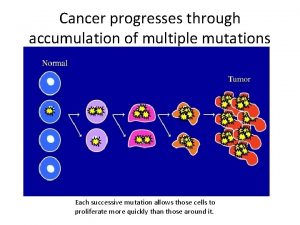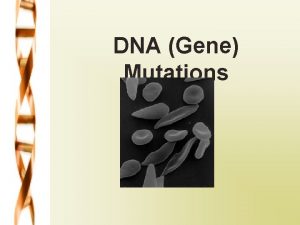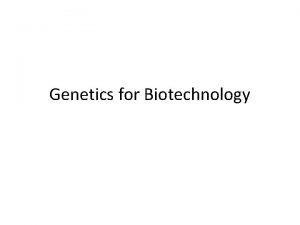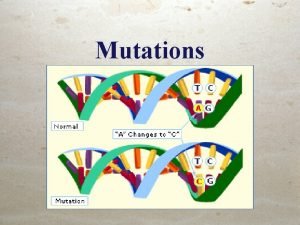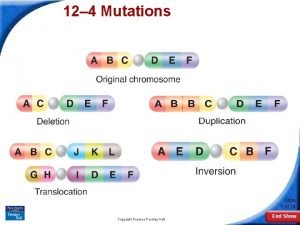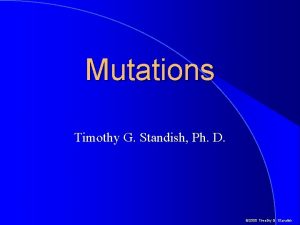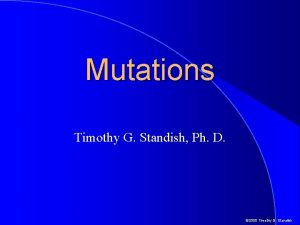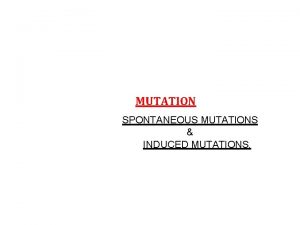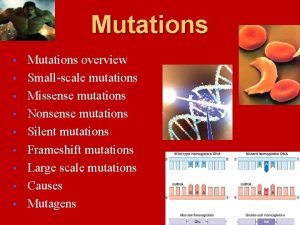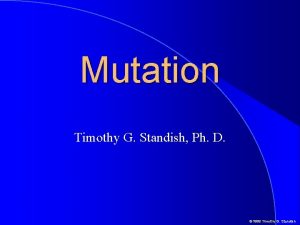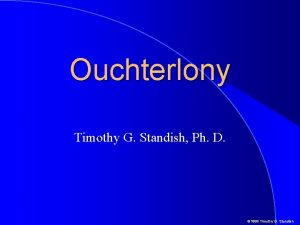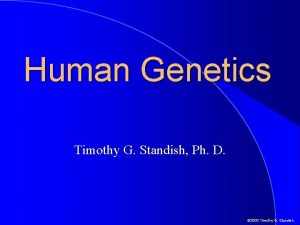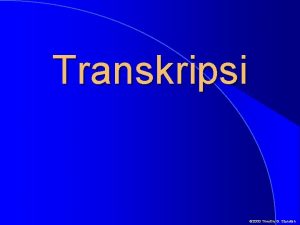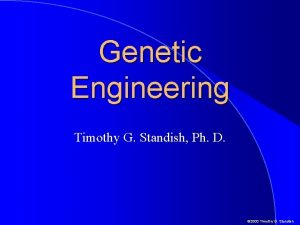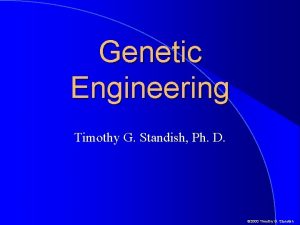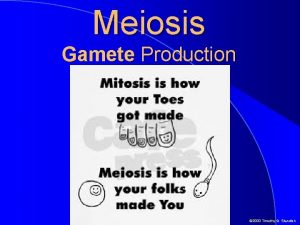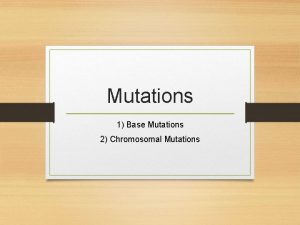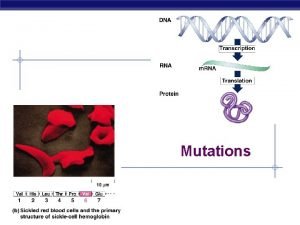Mutations Timothy G Standish Ph D 2000 Timothy

















- Slides: 17

Mutations Timothy G. Standish, Ph. D. © 2000 Timothy G. Standish

� Charles The Modern Synthesis Darwin recognized that variation existed in populations and suggested natural selection as a mechanism for choosing some variants over others resulting in survival of the fittest and gradual changes in populations of organisms. � Without a mechanism for generation of new variation, populations would be selected into a corner where only one variation would survive and new species could never arise. � The Modern Synthesis combines the mechanism of mutation in DNA to generate variation with natural selection of individuals in populations to produce new species. © 2000 Timothy G. Standish

Introduction The Central Dogma of Molecular Biology Cell DNA Transcription Translation m. RNA Ribosome Polypeptide (protein) © 1998 Timothy G. Standish

Mutation � Mutation = Change � Biologists use the term “mutation” when talking about any change in the genetic material. Not all result in a change in phenotype. � There are two major types of mutations: � Macromutations - Also called macrolesions and chromosomal aberations. Involve changes in large amounts of DNA. � Micromutations - Commonly called point mutations and microlesions. © 2000 Timothy G. Standish

Macromutations �Four major types of Macromutations are recognized: 1 Deletions - Loss of chromosome sections 2 Duplications - Duplication of chromosome sections 3 Inversions - Flipping of parts of chromosomes 4 Translocations - Movement of one part of a chromosome to another part © 2000 Timothy G. Standish

Macromutation - Deletion Chromosome Centromere Genes A B C D E F A B C D G H E F © 2000 Timothy G. Standish

Macromutation - Duplication Chromosome Centromere Genes A B C D E F G H Duplication © 2000 Timothy G. Standish

Macromutation - Inversion Chromosome Centromere Genes A B C D E F A B C D F E Inversion G H © 2000 Timothy G. Standish

Macromutation - Translocation Chromosome Centromere A B C A B E Genes D F E C F G H D G H © 2000 Timothy G. Standish

Micro or Point Mutations � Two major types of Macromutations are recognized: 1 Frame Shift - Loss or addition of one or two nucleotides 2 Substitutions - Replacement of one nucleotide by another one. There a number of different types: – Transition - Substitution of one purine for another purine, or one pyrimidine for another pyrimidine. – Transversion - Replacement of a purine with a pyrimidine or vice versa. © 2000 Timothy G. Standish

Frame Shift Mutations 3’AGTTCAG-TAC-TGA-ACA-CCA-TCA-ACT-GATCATC 5’ 5’AGUC-AUG-ACU-UGU-GGU-AGU-UGA-CUAGAAA Met Thr Cys Gly Ser 3’AGTTCAG-TAC-TGA-AAC-CAT-CAA-CTG-ATCATC 5’ 5’AGUC-AUG-ACU-UUG-GUA-GUU-GAC-UAG-AAA 3 Met Thr Leu Val Val Frame shift mutations tend to have a dramatic effect on proteins as all codons down stream from the mutation are changed and thus code for different amino acids. As a result of the frame shift, the length of the polypeptide may also be changed as a stop codon will probably come at a different spot than the original stop codon. © 2000 Timothy G. Standish

Substitution Mutations 3’AGTTCAG-TAC-TGA-ACA-CCA-TCA-ACT-GATCATC 5’ 5’AGUC-AUG-ACU-UGU-GGU-AGU-UGA-CUAGAAA Transition Met Thr Cys Gly Ser 3’AGTTCAG-TAC-TGA-ATA-CCA-TCA-ACT-GATCATC 5’ 5’AGUC-AUG-ACU-UAU-GGU-AGU-UGA-CUAGAAA Met Thr Tyr Gly Ser Pyrimidine to Pyrimidine 3’AGTTCAG-TAC-TGA-ACA-CCA-TCA-ACT-GATCATC 5’ 5’AGUC-AUG-ACU-UGU-GGU-AGU-UGA-CUAGAAA Transversion Met Thr Cys Gly Ser 3’AGTTCAG-TAC-TGA-AAA-CCA-TCA-ACT-GATCATC 5’ 5’AGUC-AUG-ACU-UUU-GGU-AGU-UGA-CUAGAAA Met Thr Phe Gly Ser Purine to Pyrimidine © 2000 Timothy G. Standish

Transitions Vs Transversions � Cells have many different mechanisms for preventing mutations � These mechanisms make mutations very uncommon � Even when point mutations occur in the DNA, there may be no change in the protein coded for � Because of the way these mechanisms work, transversions are less likely than transitions � Tranversions tend to cause greater change in proteins than transitions

The Genetic Code Neutral Non-polar Polar Basic Acidic F I U R S C T †Have amine groups *Listed as non-polar by some texts B A A S G E SECOND U UUC UUA UUG CUU CUC CUA CUG Phe Leu C UCU UCC UCA UCG CCU CCC CCA CCG AUU AUC Ile AUA AUGMet/start ACU ACC ACA ACG GUU GUC GUA GUG GCU GCC GCA GCG Val BASE A Ser UAU UAC UAA UAG Tyr Pro CAU CAC CAA CAG His Thr AAU AAC AAA AAG Asn† Ala GAU GAC GAA GAG Asp Stop Gln† Lys Glu G UGU UGC UGA UGG CGU CGC CGA CGG AGU AGC AGA AGG GGU GGC GGA GGG Cys Stop Trp U C A G Arg U C A G Ser Arg Gly* U C A G T H I R D B A S E © 2000 Timothy G. Standish

The Sickle Cell Anemia Mutation Normal b-globin DNA C Mutant b-globin DNA T T C A T G A A G U A m. RNA Normal b-globin Mutant b-globin Glu H 2 N C C Val O OH H CH 2 H 2 C C OH O Acid H 2 N C C O OH H CH CH 3 H 3 C Neutral Non-polar

Sickle Cell Anemia: A Pleiotropic Trait Mutation of base 2 in b globin codon 6 from A to T causing a change in meaning from Glutamate to Valine Mutant b globin is produced Breakdown of Red blood cells Anemia Clogging of small Blood vessels Tower skull Weakness Heart failure Impaired mental function Accumulation of sickled Cells in the spleen Red blood cells sickle Brain damage Paralysis Pain and Fever Damage to other organs Rheumatism Kidney failure Spleen damage Infections Especially Pneumonia © 2000 Timothy G. Standish

© 2000 Timothy G. Standish
 Timothy standish
Timothy standish Timothy standish
Timothy standish Timothy g. standish
Timothy g. standish Timothy g. standish
Timothy g. standish Standish group chaos report 2020
Standish group chaos report 2020 Skyward standish
Skyward standish Standish management
Standish management Types of substitution mutations
Types of substitution mutations Tensions mutations et crispations de la société d'ordres
Tensions mutations et crispations de la société d'ordres Protein synthesis and mutations
Protein synthesis and mutations Monstrous mutations
Monstrous mutations Cancer mutations
Cancer mutations Mutation reverse
Mutation reverse Protein synthesis and mutations
Protein synthesis and mutations Mutation causes
Mutation causes Mutations quiz
Mutations quiz A mutation is any mistake or change in the
A mutation is any mistake or change in the 12-4 mutations
12-4 mutations
